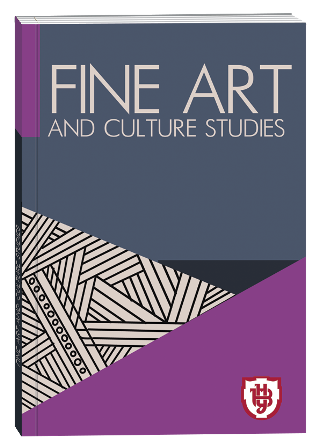CHINESE TRADITIONAL INSTRUMENTAL ENSEMBLE AND ORCHESTRA PERFORMANCE: DETERMINANTS OF HISTORICAL DEVELOPMENT
DOI:
https://doi.org/10.32782/facs-2024-1-12Keywords:
determinants of historical development, imperial era, modern period, Chinese traditional art, instrumental ensemble and orchestral music making, folk orchestral performance.Abstract
One of the bright manifestations of national culture, which characterizes hearing and perception of sound space, is traditional instrumental performance. Various artistic artifacts and forms of implementation of traditional instrumental art, being often the only evidence of ancient eras or certain historical periods, reflect its deep connection with the creativity of the bearers of ethnic musical culture. All these qualities are characteristic of Chinese traditional instrumental-ensemble and orchestral performance, which was one of the first to arise and develop on the planet. The purpose of the article is to highlight the determinants of the historical development of Chinese traditional instrumental-ensemble and orchestral performance, to reveal its specificity, forms of functioning, and national originality. The methodological basis. The historical and cultural method was used to establish cause-and-effect relationships in the development of Chinese instrumental-ensemble and orchestral music; structural and functional – to determine the role of traditional instrumental ensemble and orchestral performance in the creation of various genres and forms of Chinese music; cognitive – to learn the specifics of the development of the specified genre as a socially conditioned phenomenon. Other methods include analysis, systematization, generalization, collection, and description. Scientific novelty of the article. The issue of determinism of the development process, specificity, form of functioning, national features of Chinese instrumental-ensemble and orchestral performance was not considered in a separate work, which determines the novelty of the proposed topic. Conclusions of the article. The evolution of Chinese traditional instrumental-ensemble and orchestral performance is determined by several qualitatively different stages of socio-cultural and political development. Thus, in the Zhou period (XI–III centuries BC) there is a philosophical awareness of the role of music in society, the regulation of performance in court ceremonial events, the classification of traditional instruments (bain), the lui-lui system, and the composition of instrumental orchestras are introduced. And ensembles. During the reign of the Qin (221,206 BC), Han (206 BC – 220 AD) and Tang (618–907) dynasties, the process of institutionalization of art begins (the creation of special institutions “Dasiyue”, “Dayueshu”, “Kuchueiyueshu”, “Jiaoyufan”), there is a genre branching of music in the open air (li-puchi) and indoors (tso-puchi), along with the classical court music “yayue”, are developing banquet -ceremonial “yanyue”, parade-military “kuchueyyue”, song-dance “datsui” and instrumental. The two periods of the song dynasty – Northern (960–1127) and Southern (1127–1279) – influenced the formation of the styles of instrumental music Beicui (northern melody) and Nanciu (southern melody). The traditions of ensemble and orchestral music-making established in the tangsun era were preserved until the middle of the 19th century. The end of the reign of the last imperial dynasty (1911) led to the abandonment of national traditions in China. The revival of traditional instrumental-ensemble and folk orchestral performance begins in the period of independent People’s Republic of China (1949).
References
Іжик М. Традиційні музичні інструменти. Ерху. Міжнародне радіо Китаю. URL: http://www.mr.co.ua/mr/mr.nsf/0/A3E4955B61AA7399C225817F0078435B?OpenDocument (дата звернення: 10.02.2024).
Музика Китаю : вікіпедія. URL: https://uk.wikipedia.org/wiki/%D0%9C%D1%83%D0%B7%D0%B8%D0%B
A%D0%B0_%D0%9A%D0%B8%D1%82%D0%B0%D1%8E (дата звернення: 10.02.2024).
Музика Китаю [електронний ресурс]. URL : https://hmn.wiki/uk/Music_of_China (дата звернення: 10.02.2024).
Сун Пенсян. Становлення і розвиток китайського музичного інструментарію. Вісник ДАКККіМ : наук. журнал. Київ : Міленіум, 2007. Вип. 2. С. 77–81.
Сун Пенсян. Вплив релігійно-філософських та ідеологічних доктрин на розвиток музичного мистецтва Китаю. Вісник ДАКККіМ : наук. журнал. Київ : Міленіум, 2007. Вип. 3. С. 87–91.
Чень Наньпу. Китайські мембранофони та ідіофони в контексті однотипного інструментарію давніх цивілізацій і народних традицій Азії : дис. … канд. мистецтвознавства, спец. 17.00.03 Музичне мистецтво. ЛНМА імені М.В. Лисенка. Львів, 2019. 267 с.
Ян Чжеюй. Китайсько-європейські інтеграційні процеси у розвитку професійної музичної культури України. Наука в контексті глобальної трансформації суспільства : мат-ли науково-практ. конф. (м. Полтава, 26–27 серпня 2022 р.). Одеса : «Молодий вчений», 2022. С. 21–23.
Ян Чжеюй. Формування та розвиток жанру інструментального концерту для дерев’яних духових інструментів у китайській музиці. Актуальнi питання гуманiтарних наук. Вип 53, том 2. Мистецтвознавство. 2022. С. 133–137.
Braudel F. La Grammaire des civilisations. Paris: Flammarion, 2013. 757 p. Web. URL: https://lirsa.cnam.fr/
medias/fichier/braudel_civhtml_1263217459406.html#resume (дата звернення: 10.02.2024).
Instruments of the Traditional Chinese Orchestra. URL : https://web.northeastern.edu/music-chinese/guzheng/ (дата звернення: 10.02.2024).







